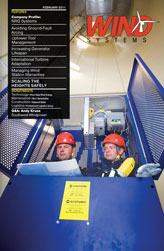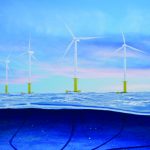The northeastern and mid-Atlantic U.S. is an attractive region for future wind park developments due to good wind resources, state incentives, and ease to grid connection in the vicinity of major populated areas. The associated colder climate conditions sound promising at first sight because of possibly strong winds and higher air density, e.g. air at -30C is 26.7 percent denser than air at +35C. However, a colder region may be subject to a number of meteorological icing conditions that have the following adverse effects on wind energy production: loss of energy production due to turbine shutdown during/after icing events; reduced energy production due to disrupted aerodynamics; overloading due to delayed stall; increased fatigue due to imbalance in the ice loads, and; safety concerns caused by uncontrolled ice shedding. The cost of energy (COE) of wind-produced energy is driven by O&M and availability. It is critical to ensure that wind turbine icing does not affect these two important COE factors to an extent that would endanger the profitability of energy produced by wind in colder climates. We therefore need to enhance our understanding of the nature and prediction of meteorological icing conditions, the physics of ice accretion and its effect on blade aerodynamics and power production, the safety concerns, and to develop strategies to mitigate those adverse effects by developing anti-icing and operational strategies.
The “ice type” that accretes on a structure is mainly governed by the ambient air temperature (T), the Liquid Water Content (LWC), and the Median Volumetric Droplet Diameter (MVD). The accreted ice mass is then proportional to the duration of the icing event (t) and the wind speed (V). The two main ice types are rime ice, and glaze ice. Rime ice occurs at low T and low LWC. Droplets freeze immediately upon surface impact resulting in low density ice growth upstream of the airfoil. It is the primary ice type concerning aircraft icing during flight. Glaze ice occurs at higher T (close to freezing temperatures) and higher LWC than rime ice. Here the droplets do not free immediately, but run along the airfoil. This leads to high density “horn-shape” ice growth along the airfoil (see figure). Glaze ice is significantly more difficult to predict and is the primary ice type that occurs on wind turbine blades.
Available ice accretion models are oftentimes only validated for two-dimensional flow under rime ice conditions. Model validation for three-dimensional glaze ice accretion is inherently difficult. Particularly, no validation data are available for run-back effects along the blade airfoil section and in the radial direction due to centrifugal effects. Only a few field data sets of actually accreted wind turbine ice shapes are available. However, their quantitative correlation to the actual meteorological icing event conditions is never entirely conclusive. The Adverse Environment Rotor Test Stand (AERTS) of the Vertical Lift Research Center of Excellence (VLRCOE) at the Pennsylvania State University is a unique facility that enables scaled tests of meteorological icing events for rotating wind turbine blades. The accompanying figure shows a Computational Fluid Dynamics (CFD) simulation around an AERTS accreted ice shape that is helpful in understanding the aerodynamics of iced wind turbine blades. Further research is being conducted. Chart 1
At present wind turbines subject to meteorological icing conditions are being shut down as soon as a vibratory load threshold is reached, generally caused by load imbalances. This is necessary in order to mitigate effects on machine life and safety concerns. Research is needed to provide insights into the physics of ice accretion on wind turbine blades, leading to improved designs and operational conditions—including tip-speed-ratio, blade pitch, and novel airfoil designs—that minimize ice accretion during icing events. The main objective must always be not to lose availability, and not to increase O&M requirements.
Possible strategies for anti-icing include blade heating, hydrophobic surface coatings, spray coatings, and ultrasound, with all having downsides in terms of energy requirement, weight, durability, O&M, and availability. We need to think more about this problem. Wind turbine icing is too important to be ignored by manufacturers, operators, and academia. There is a lot to do, and a lot can be done. Every percent in capacity factor counts toward the competitiveness of wind energy.





























